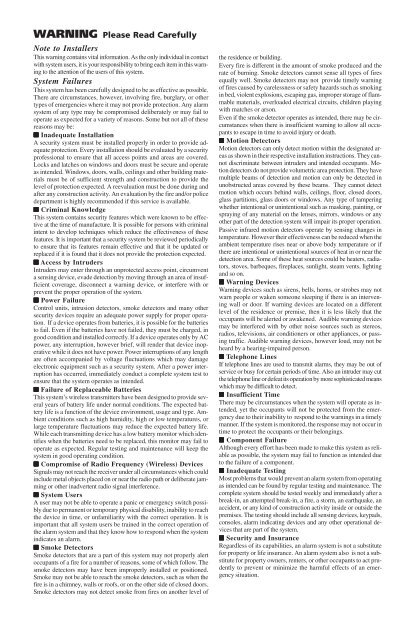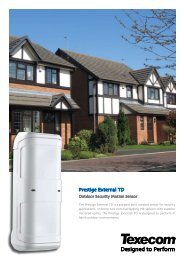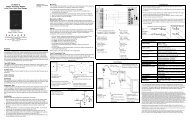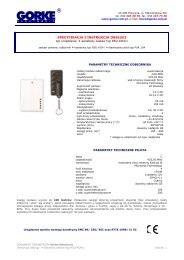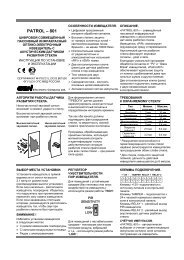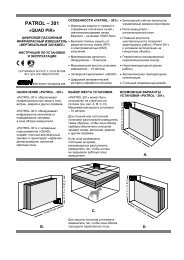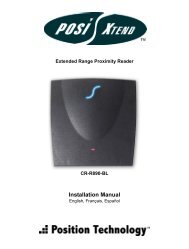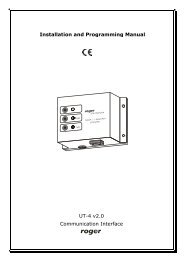PC5132-433 install.pdf
PC5132-433 install.pdf
PC5132-433 install.pdf
You also want an ePaper? Increase the reach of your titles
YUMPU automatically turns print PDFs into web optimized ePapers that Google loves.
WARNING Please Read CarefullyNote to InstallersThis warning contains vital information. As the only individual in contactwith system users, it is your responsibility to bring each item in this warningto the attention of the users of this system.System FailuresThis system has been carefully designed to be as effective as possible.There are circumstances, however, involving fire, burglary, or othertypes of emergencies where it may not provide protection. Any alarmsystem of any type may be compromised deliberately or may fail tooperate as expected for a variety of reasons. Some but not all of thesereasons may be:■ Inadequate InstallationA security system must be <strong>install</strong>ed properly in order to provide adequateprotection. Every <strong>install</strong>ation should be evaluated by a securityprofessional to ensure that all access points and areas are covered.Locks and latches on windows and doors must be secure and operateas intended. Windows, doors, walls, ceilings and other building materialsmust be of sufficient strength and construction to provide thelevel of protection expected. A reevaluation must be done during andafter any construction activity. An evaluation by the fire and/or policedepartment is highly recommended if this service is available.■ Criminal KnowledgeThis system contains security features which were known to be effectiveat the time of manufacture. It is possible for persons with criminalintent to develop techniques which reduce the effectiveness of thesefeatures. It is important that a security system be reviewed periodicallyto ensure that its features remain effective and that it be updated orreplaced if it is found that it does not provide the protection expected.■ Access by IntrudersIntruders may enter through an unprotected access point, circumventa sensing device, evade detection by moving through an area of insufficientcoverage, disconnect a warning device, or interfere with orprevent the proper operation of the system.■ Power FailureControl units, intrusion detectors, smoke detectors and many othersecurity devices require an adequate power supply for proper operation.If a device operates from batteries, it is possible for the batteriesto fail. Even if the batteries have not failed, they must be charged, ingood condition and <strong>install</strong>ed correctly. If a device operates only by ACpower, any interruption, however brief, will render that device inoperativewhile it does not have power. Power interruptions of any lengthare often accompanied by voltage fluctuations which may damageelectronic equipment such as a security system. After a power interruptionhas occurred, immediately conduct a complete system test toensure that the system operates as intended.■ Failure of Replaceable BatteriesThis system’s wireless transmitters have been designed to provide severalyears of battery life under normal conditions. The expected batterylife is a function of the device environment, usage and type. Ambientconditions such as high humidity, high or low temperatures, orlarge temperature fluctuations may reduce the expected battery life.While each transmitting device has a low battery monitor which identifieswhen the batteries need to be replaced, this monitor may fail tooperate as expected. Regular testing and maintenance will keep thesystem in good operating condition.■ Compromise of Radio Frequency (Wireless) DevicesSignals may not reach the receiver under all circumstances which couldinclude metal objects placed on or near the radio path or deliberate jammingor other inadvertent radio signal interference.■ System UsersA user may not be able to operate a panic or emergency switch possiblydue to permanent or temporary physical disability, inability to reachthe device in time, or unfamiliarity with the correct operation. It isimportant that all system users be trained in the correct operation ofthe alarm system and that they know how to respond when the systemindicates an alarm.■ Smoke DetectorsSmoke detectors that are a part of this system may not properly alertoccupants of a fire for a number of reasons, some of which follow. Thesmoke detectors may have been improperly <strong>install</strong>ed or positioned.Smoke may not be able to reach the smoke detectors, such as when thefire is in a chimney, walls or roofs, or on the other side of closed doors.Smoke detectors may not detect smoke from fires on another level ofthe residence or building.Every fire is different in the amount of smoke produced and therate of burning. Smoke detectors cannot sense all types of firesequally well. Smoke detectors may not provide timely warningof fires caused by carelessness or safety hazards such as smokingin bed, violent explosions, escaping gas, improper storage of flammablematerials, overloaded electrical circuits, children playingwith matches or arson.Even if the smoke detector operates as intended, there may be circumstanceswhen there is insufficient warning to allow all occupantsto escape in time to avoid injury or death.■ Motion DetectorsMotion detectors can only detect motion within the designated areasas shown in their respective <strong>install</strong>ation instructions. They cannotdiscriminate between intruders and intended occupants. Motiondetectors do not provide volumetric area protection. They havemultiple beams of detection and motion can only be detected inunobstructed areas covered by these beams. They cannot detectmotion which occurs behind walls, ceilings, floor, closed doors,glass partitions, glass doors or windows. Any type of tamperingwhether intentional or unintentional such as masking, painting, orspraying of any material on the lenses, mirrors, windows or anyother part of the detection system will impair its proper operation.Passive infrared motion detectors operate by sensing changes intemperature. However their effectiveness can be reduced when theambient temperature rises near or above body temperature or ifthere are intentional or unintentional sources of heat in or near thedetection area. Some of these heat sources could be heaters, radiators,stoves, barbeques, fireplaces, sunlight, steam vents, lightingand so on.■ Warning DevicesWarning devices such as sirens, bells, horns, or strobes may notwarn people or waken someone sleeping if there is an interveningwall or door. If warning devices are located on a differentlevel of the residence or premise, then it is less likely that theoccupants will be alerted or awakened. Audible warning devicesmay be interfered with by other noise sources such as stereos,radios, televisions, air conditioners or other appliances, or passingtraffic. Audible warning devices, however loud, may not beheard by a hearing-impaired person.■ Telephone LinesIf telephone lines are used to transmit alarms, they may be out ofservice or busy for certain periods of time. Also an intruder may cutthe telephone line or defeat its operation by more sophisticated meanswhich may be difficult to detect.■ Insufficient TimeThere may be circumstances when the system will operate as intended,yet the occupants will not be protected from the emergencydue to their inability to respond to the warnings in a timelymanner. If the system is monitored, the response may not occur intime to protect the occupants or their belongings.■ Component FailureAlthough every effort has been made to make this system as reliableas possible, the system may fail to function as intended dueto the failure of a component.■ Inadequate TestingMost problems that would prevent an alarm system from operatingas intended can be found by regular testing and maintenance. Thecomplete system should be tested weekly and immediately after abreak-in, an attempted break-in, a fire, a storm, an earthquake, anaccident, or any kind of construction activity inside or outside thepremises. The testing should include all sensing devices, keypads,consoles, alarm indicating devices and any other operational devicesthat are part of the system.■ Security and InsuranceRegardless of its capabilities, an alarm system is not a substitutefor property or life insurance. An alarm system also is not a substitutefor property owners, renters, or other occupants to act prudentlyto prevent or minimize the harmful effects of an emergencysituation.


